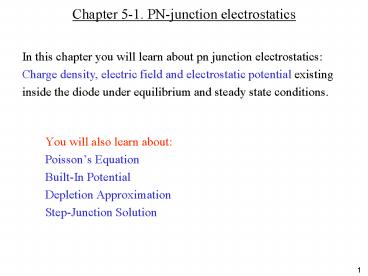Chapter 51' PNjunction electrostatics - PowerPoint PPT Presentation
1 / 15
Title:
Chapter 51' PNjunction electrostatics
Description:
1. Chapter 5-1. PN-junction electrostatics. You will also learn about: Poisson's Equation ... Electrostatic variables for the equilibrium pn junction. Potential, ... – PowerPoint PPT presentation
Number of Views:96
Avg rating:3.0/5.0
Title: Chapter 51' PNjunction electrostatics
1
Chapter 5-1. PN-junction electrostatics
In this chapter you will learn about pn junction
electrostatics Charge density, electric field
and electrostatic potential existing inside the
diode under equilibrium and steady state
conditions.
- You will also learn about
- Poissons Equation
- Built-In Potential
- Depletion Approximation
- Step-Junction Solution
2
PN-junction fabrication
PN-junctions are created by several processes
including 1. Diffusion 2. Ion-implantation 3.
Epitaxial deposition Each process results in
different doping profiles
3
Ideal step-junction doping profile
4
Equilibrium energy band diagram for the pn
junction
EF same everywhere under equilibrium
Join the two sides of the band by a smooth curve.
5
Electrostatic variables for the equilibrium pn
junction
Potential, V ? (1/q) (ECEref). So, potential
difference between the two sides (also called
built-in voltage, Vbi) is equal to ?(1/q)(?EC).
? charge density ? Ks ?o
6
Conceptual pn-junction formation
p and n type regions before junction formation
Holes and electrons will diffuse towards opposite
directions, uncovering ionized dopant atoms. This
will build up an electric field which will
prevent further movement of carriers.
7
The built-in potential, Vbi
When the junction is formed, electrons from the
n-side and holes from the p-side will diffuse
leaving behind charged dopant atoms. Remember
that the dopant atoms cannot move! Electrons
will leave behind positively charged donor atoms
and holes will leave behind negatively charged
acceptor atoms. The net result is the build up
of an electric field from the positively charged
atoms to the negatively charged atoms, i.e.,
from the n-side to p-side. When steady state
condition is reached after the formation of
junction (how long this takes?) the net electric
field (or the built in potential) will prevent
further diffusion of electrons and holes. In
other words, there will be drift and diffusion
currents such that net electron and hole currents
will be zero.
8
Equilibrium conditions
Under equilibrium conditions, the net electron
current and hole current will be zero.
E-field
NA 1017 cm?3
ND 1016 cm?3
hole diffusion current
hole drift current
electron diffusion current opposite to electron
flux
electron drift current opposite to electron flux
9
The built-in potential, Vbi
p-side
n-side
EC Ei EV
q Vbi (Ei ?? EF)p-side (EF ? Ei)n-side
10
The built-in potential, Vbi
The built-in potential, Vbi, measured in Volts,
is numerically equal to the shift in the bands
expressed in eV.
Vbi (1/q) (Ei ? EF)p-side (EF?? Ei)n-side
An interesting fact
11
Majority and minority carrier concentrations
p-side NA ND n-side
pp
nn
pn
np
x
?xp xn
12
Built-in potential as a function of doping
concentration for an abrupt pn or np junction
13
Depletion approximation
Poisson equation
We assume that the free carrier concentration
inside the depletion region is zero.
14
Example 1
A p-n junction is formed in Si with the following
parameters. Calculate the built-in voltage, Vbi.
ND 1016 cm3 NA 1017 cm3
Calculate majority carrier concentration in
n-side and p-side. Assume nn ND 1016 cm?3 and
pp NA 1017 cm?3.
Plug in the numerical values to calculate Vbi.
15
Example 2
A pn junction is formed in Si with the following
parameters. Calculate the built-in voltage, Vbi.
Calculate majority carrier concentration in
n-side and p-side. nn effective ND 1016
cm-3 pp effective NA 1017 cm3
Here NA and ND are effective or net values.
Plug in the numerical values to calculate Vbi.































